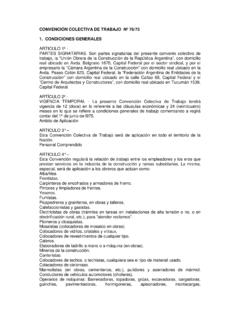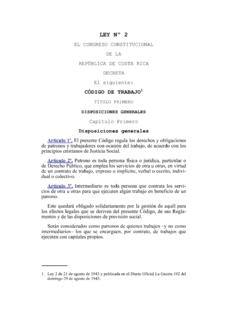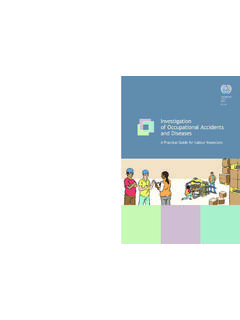Transcription of Combating Forced Labour Combating Forced …
1 Combating Forced Labour A Handbook for Employers & BusinessCombating Forced LabourSpecial Action Programme to Combat Forced Labour1 Introduction & OverviewCombating Forced LabourA Handbook for Employers & BusinessSpecial Action Programme to Combat Forced LabourCombating Forced LabourA Handbook for Employers & Business1 Introduction & OverviewSpecial Action Programme to Combat Forced LabourCopyright International Labour Organization 2015 First published 2015 Publications of the International Labour Offi ce enjoy copyright under Protocol 2 of the Universal Copyright Convention. Nevertheless, short excerpts from them may be reproduced without authorization, on condition that the source is indicated. For rights of reproduction or translation, application should be made to ILO Publications (Rights and Licensing), International Labour Offi ce, CH-1211 Geneva 22, Switzerland, or by email: The International Labour Offi ce welcomes such , institutions and other users registered with a reproduction rights organization may make copies in accordance with the licences issued to them for this purpose.
2 Visit to fi nd the reproduction rights organization in your Cataloguing in Publication Data Combating Forced Labour : a handbook for employers and business / International Labour Offi 2nd ed. - Geneva: ILO, 2015 ISBN: 9789221297994 (print); 9789221298007 (web pdf) International Labour Offi ce Forced Labour / traffi cking in persons / employers role The designations employed in ILO publications, which are in conformity with United Nations practice, and the presentation of material therein do not imply the expression of any opinion whatsoever on the part of the International Labour Offi ce concerning the legal status of any country, area or territory or of its authorities, or concerning the delimitation of its responsibility for opinions expressed in signed articles, studies and other contributions rests solely with their authors, and publication does not constitute an endorsement by the International Labour Offi ce of the opinions expressed in them.
3 Reference to names of fi rms and commercial products and processes does not imply their endorsement by the International Labour Offi ce, and any failure to mention a particular fi rm, commercial product or process is not a sign of publications and digital products can be obtained through major booksellers and digital distribution platforms, or ordered directly from For more information, visit our website: or contact thanks are due to Philip Hunter (Verit ) and, for graphic design, Julie Sobkowicz Brown for developing the revised handbook in close consultation with Houtan Homayounpour (SAP-FL), who coordinated and oversaw the in SwitzerlandPrefaceThe ILO estimates that 21 million people are currently victims of Forced Labour . Employers are committed to the elimination of this abhorrent practice.
4 Not only does it create unfair competition and ultimately affect the bottom line, but it represents a huge potential reputational risk, particularly when global supply chains have reached unprecedented levels of complexity. Forced Labour , including human traffi cking and slavery-like practices, is a violation of human rights and international Labour standards, and is thus universally condemned. No employer, anywhere, wishes to be associated with this crime. Employers are fully committed to eradicating Forced Labour in all its forms. They overwhelmingly supported the adoption of two important new ILO instruments in 2014, the Protocol to the Forced Labour Convention, 1930 and the Forced Labour Recommendation (Supplementary Measures), No. 203. The International Organisation of Employers (IOE) is an active participant in the Global Alliance against Forced Labour , launched by the ILO in 2005.
5 It has joined forces with the ILO s Special Action Programme to combat Forced Labour (SAP-FL) to sensitize employers to the risks of Forced Labour and to promote effective mitigation measures. This newly revised edition of the Employers Handbook on Forced Labour , produced jointly by the IOE and the ILO, offers updated guidance to employers on what Forced Labour is, how to detect it and effective ways to combat it, thereby ensuring that business operations remain free of such practices. The revised handbook refl ects new ILO statistics and research on Forced Labour as well as the framework of action approved by the ILO Governing Body in 2014. It takes into account as well the UN Guiding Principles on Business and Human Rights, endorsed by the Human Rights Council in IOE and the ILO look forward to future close collaboration on this critical component of fundamental rights at work and invite employers organisations across the world to join forces to eliminate Forced Labour .
6 Linda Kromjong Secretary GeneralInternational Organisation of EmployersBeate AndreesHeadSpecial Action Programme to Combat Forced Labour International Labour Organization11234567 IntroductionForced Labour and human traffi cking for the purpose of Forced Labour are becoming increasingly important issues for employers organisations and business. This handbook aims to help business actors at different levels address the issue, providing practical tools and guidance material to enable them to identify and prevent situations of Forced organisations and business have a central role to play in Combating all forms of Forced or compulsory Labour . Employers organisations, in particular, are strategically well-placed to provide institutional engagement and sustainability, and business involvement is key to the success of the ILO s campaign to ensure that by 2019 Forced Labour will no longer persist at a scale estimated by the ILO to affect million women, men and children are many reasons why business and employers organisations should play a central role in the global fi ght to end Forced Labour and human traffi cking: Legal compliance: The vast majority of ILO member States have ratifi ed Conventions 29 and 105 on Forced or compulsory Labour , and have ratifi ed the Palermo Protocol against human traffi cking.
7 Consequently, they are required to make this practice a crime. This means Forced Labour and human traffi cking are punishable as crimes in most countries around the world, and that companies found involved in such activities could face prosecution. Managing risk and reputation: To be successful, companies must manage risk in an environment where risk is not static and can emerge through the actions of the company itself, its suppliers and other actors. Allegations of Forced Labour and traffi cking present legal risks as well as serious threats to brand and company reputation. Forced Labour in global supply chains: Globalisation and the growing links across countries and fi rms have raised Forced Labour and traffi cking in persons as signifi cant issues within global supply chains. Codes of conduct and corporate social responsibility (CSR): The elimination of Forced Labour is a key element of codes of conduct and other CSR initiatives.
8 Companies particularly those that supply consumer markets and have signifi cant brand value face new and growing expectations that production will comply with social and human rights criteria. Trade and investment risk: In some countries, trade regulations prohibit the import of goods that have been produced by Forced or traffi cked Labour . In these jurisdictions, such allegations can result in confi scation of imported goods by public authorities or disruption to trade and production 21234567schedules. Allegations of Forced Labour and traffi cking can also signifi cantly threaten investor relations and jeopardize access to public funds such as export credits. Forced Labour and human traffi cking are morally of the handbookThis handbook is addressed to employers organisations and a broad spectrum of business actors that include small and medium sized enterprises, multinational enterprises, export-oriented companies and those operating within global supply chains.
9 Senior managers, human resource personnel, sourcing and social compliance staff, and social auditors are among those who will fi nd material and information here that will help them in their day-to-day work. Organisations within the broader community of CSR as well as companies providing management services for example, consultants or quality control companies will also fi nd this handbook handbook s main aim is to assist business and employers organisations in understanding and tackling the various dimensions and issues related to Forced Labour and human traffi cking, acknowledging that each company and organisation is unique and has different needs and priorities. These are truly global phenomena, affecting all countries in the world today. Forced Labour thus presents a signifi cant risk to global businesses as well as their national and international representatives.
10 The handbook has the following specifi c aims: To raise awareness of Forced Labour and human traffi cking, what they are, and where they can be found; To provide practical material and guidance to different business actors and employers organisations to encourage efforts to combat Forced Labour and human traffi cking; To support employers in their engagement on the issues and propose specifi c measures to help them take preventive action against the risk of Forced Labour ; To facilitate a better understanding of international standards addressing these issues; To serve as a resource book and guide for further to use the handbookThis handbook has been designed for practical use by the business community. It takes the form of stand-alone tools and booklets that provide practical guidance to help business address Forced Labour .

















